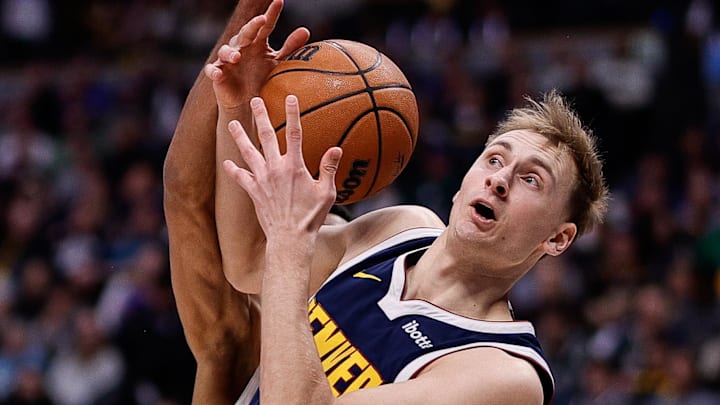Third-year players are supposed to dominate during Summer League. Yet Hunter Tyson struggled in Las Vegas, dropping just 12.5 points per game on 32.1% shooting from the floor and 27.3% from deep, while snatching down a healthy 9.5 rebounds across 28.6 minutes per game.
No, Summer League is not necessarily the kind of basketball in which players like Tyson — hardworking defender, rebounder, connector, and (theoretical) shooter — shine. However, we’ve seen the young Nuggets veteran forward out of Clemson excel in Vegas before (All-Summer League First Team in 2023), so his uneven and inefficient shooting performance across two games this year feels like a troubling sign.
Unfortunately for Tyson, the lack of “pop” or standout moments against Summer League competition carries over from recent NBA outings. And this most recent mediocre outing might matter more than typical Summer League struggles since the Nuggets have to decide on his contract next summer.
Will the new-look front office give him one final shot to catch on during the regular season? Or will Ben Tenzer and Jon Wallace leverage their newfound flexibility to move on from Tyson and onto a more productive veteran minimum player?
Contract Situation Creates Urgency
As noted, Denver has a team option on Tyson’s contract for the 2026-27 season, so the onus is on the “Monroe Menace” to prove his worth and carve out a role on this roster.
In 69 career games, Tyson’s averaging only 2.2 points per game, shooting 37.5% from the field, 1.3 boards, 0.3 assists, and 0.3 stocks. He’s played fewer than 500 career minutes, and the per-36 numbers don’t look as horrific (12.4 points, 7 rebounds, 1.8 assists), but there’s no clear path to minutes for Tyson following the additions of Cameron Johnson, Bruce Brown and Tim Hardaway Jr. Heck, I’d contend Tyson’s the last player in line for minutes next season that’s not signed to a two-way contract.
With the deadline for the Nuggets to decide whether to exercise Tyson’s $2.4 million contract on June 29, 2026, Tyson’s time is running out. Given the logjam ahead of him in the rotation and the likelihood of diminishing returns on the trade market, should the franchise wait until next summer?
A Two-Year Shooting Slump at the NBA Level
A somewhat surprising second-round pick, Tyson shot 40.5% from three-point range on six attempts and pulled down nearly 10 rebounds per game during his senior season at Clemson.
After not seeing the floor much during his rookie season, playing just 48 minutes, Tyson’s 4/14 three-point performance was excusable following his encouraging initial Summer League outing. Even better, Tyson shot 40-plus percent from deep on 9.2 3PA/game for the G League’s Grand Rapids Gold in 2023-24, so the positive signs were there.
But Tyson once again battled with his perimeter shot in Vegas last summer, splashing just 31.4% of his seven attempts per game. And those difficulties extended into the 2024-25 regular season, with the college sharp-shooter knocking down only 23 of 74 threes (31.1%).
Can he find his shot again ahead of the 2025-26 season? Did he show enough growth in other areas during Summer League? Or is it time to give his minutes to a promising young shooter in Curtis Jones or a two-way player who shares the same position in Spencer Jones?
What the Nuggets Need vs. What Tyson Provides
Based on the offseason moves made, I’d surmise this front office prioritizes reliable three-point shooting. While this was supposed to be Tyson’s strength coming into the league, his presence as a consistent perimeter threat has failed to materialize thus far in his NBA career.
Coming out of Clemson, the scout on Tyson was an experienced floor-spacing wing of great size who could rebound well. Essentially a 50%-40%-85% shooter during his fifth year at Clemson, Tyson’s struggles making shots from three are well documented to this point, but he’s also failed to make a marked difference on the boards to this point.
With Spencer Jones showing progress with his three-point shot — 45.5% on 5.5 attempts per game during Summer League — another option on the Nuggets roster exists to fill a role similar to that of Hunter Tyson. The second-year forward from Stanford showed some defensive chops and gets into his stance to move around well on that end, so he provides more theoretical three-and-D value than Tyson from the forward spot, assuming the shot falls.
And that goes without mentioning other forwards locked into the rotation like Aaron Gordon and Peyton Watson, as well as the aforementioned Johnson, Brown, and Hardaway Jr. Zeke Nnaji and DaRon Holmes II might even vie for some backup forward minutes off the bench next season.
All of that said, Tyson’s future in the Mile High City does not look ideal.
The Case for Moving On Early
Following the MPJ-for-Cam Johnson trade, the Nuggets front office found significantly more roster flexibility than it previously possessed, making the prospect of cutting an inexpensive end-of-bench guy like Tyson a possibility.
While the Kroenkes are never quick to pay players to take their talents elsewhere, the potential of adding another vet minimum (perhaps a ball-handling guard and/or point-of-attack defender) to the roster now, AND maintaining the final open roster spot into the season ought to be enticing.
In addition to potentially adding more help now, the team can focus its development resources on more promising prospects in Holmes II or maybe even two-way guys like the Joneses and Tamar Bates.
Time for Tough Decisions
Patience might pay off for Tyson in Denver, but the Nuggets front office can’t wait during Nikola Jokic’s prime years. It’s go time, and that might mean cutting bait with a young prospect who’s not yet panned out.
Every roster spot matters. Every opportunity to improve this team is precious. We can’t hope Hunter Tyson becomes something he’s not.
Jokic’s prime won’t wait. And neither should the Nuggets.
